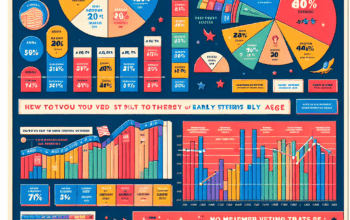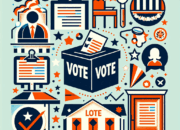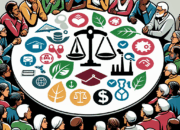Introduction
As we delve into the pivotal role of the youth vote in elections, it’s essential to recognize how this dynamic demographic is reshaping political landscapes across the globe. The new generation of voters, increasingly engaged and informed, wields significant influence over election outcomes. In 2025, the youth vote has become a key factor that politicians and parties can no longer afford to ignore. This article explores the implications of the youth vote and examines how the new generation is driving change in the electoral process, shaping policies, and fostering a more inclusive democracy.
The Significance of Youth Engagement in Elections
The youth vote represents a vital segment of the electorate that carries the potential to swing elections. In 2025, studies show that voters aged 18-29 constitute over 25% of the voting population in many countries, making their participation essential for candidates aiming for electoral success. Unlike previous generations, today’s youth are not only more likely to register to vote but also to turn out on election day, driven by issues that resonate with their values and visions for the future. Environmental concerns, social justice, and economic inequality rank high on their agendas, making them a formidable force in determining the future direction of political policies.
Furthermore, the historical context of youth voter turnout reveals a notable shift. In the 2020 elections, young voters demonstrated their political power by increasing their turnout significantly, a trend that has continued into 2025. National campaigns and local initiatives have been launched to engage young people, providing platforms that address their specific needs and interests. Consequently, this engagement has fostered a more politically conscious generation, ready to challenge the status quo and demand accountability from their leaders.
The Role of Social Media in Mobilizing the Youth Vote
In the age of digital connectivity, social media has emerged as a crucial tool for mobilizing the youth vote. Platforms such as TikTok, Instagram, and Twitter serve not only as channels for political discourse but also as effective means for organizing voter registration drives and promoting awareness around key issues. In 2025, candidates have adapted their strategies to leverage these platforms, crafting messages that resonate with younger audiences in innovative and relatable ways.
Moreover, social media’s role extends beyond mere engagement; it rapidly disseminates information, making political issues accessible and relatable. Campaigns create shareable content that not only informs but also encourages young voters to participate actively in the political process. This has led to an increase in youth-generated content, influencing public perception and motivating peers to engage in discussions about civic responsibility and voter participation.
The Legislative Impact of Young Voters on Policy Making
The growing influence of the youth vote has made it impossible for policymakers to overlook the perspectives and demands of this demographic. In 2025, elected officials are increasingly held accountable for their positions on issues that matter to young voters. Climate change, education reform, affordable housing, and healthcare access are just a few areas where youth activism has led to substantial legislative changes. Young voters have rallied for policies that reflect their values, demonstrating their unwillingness to settle for outdated political narratives and solutions.
This shift is evidenced by numerous legislative movements and initiatives aimed at addressing the concerns of younger constituents. For instance, sustainable energy policies and comprehensive education reform have become focal points for candidates seeking the youth vote. Innovative programs advocating for student loan forgiveness and mental health resources have been introduced, largely in response to the fomenting pressure from this newly engaged voter base. The impact of youth advocacy is evident in the ways they are shaping legislative priorities and pushing issues to the forefront of political discourse.
Challenges and Obstacles to Youth Participation in Elections
Despite their growing influence, the youth vote faces various challenges that can affect participation rates. Voter apathy remains a significant barrier, exacerbated by feelings of disillusionment with political systems that seem unresponsive to their needs. Additionally, misinformation and digital illiteracy can hinder the younger generation’s ability to navigate the complexities of electoral processes. In 2025, ensuring that young voters have access to accurate information is more critical than ever, especially as disinformation campaigns proliferate online.
Another crucial challenge is the accessibility of the voting process itself. Structural obstacles such as complicated voter registration systems, restrictive voting laws, and limited access to polling places disproportionately affect young voters, particularly those from marginalized communities. Advocates for youth voting rights are working tirelessly to dismantle these barriers, pushing for reforms that create a more equitable system where every eligible young person can have their voice heard.
The Future of Youth Voting and Political Engagement
Looking ahead, the future of youth voting and political engagement appears promising, if not tumultuous. As Generation Z and younger millennials mature into adulthood, their political ideals and priorities will continue to shape the electoral landscape. By 2025, educational institutions and advocacy groups are increasingly prioritizing civic education, equipping young people with the knowledge and tools necessary to engage effectively in the political process. This foundation sets the stage for even greater involvement in the years to come.
Moreover, the intersection of technology and civic participation promises exciting possibilities. As innovations such as blockchain voting systems and mobile voting apps gain traction, the electoral process may become more accessible and user-friendly for younger generations. These advancements could help overcome logistical challenges and increase turnout among young voters. If properly harnessed, technology can amplify the voices of the youth vote, ensuring their influence on future elections will only grow stronger.
Conclusion
The youth vote in 2025 stands as a testament to the power and potential of the new generation in shaping democracy and influencing elections. With high levels of engagement driven by digital connectivity and a clear understanding of the issues that matter most, young voters have proven to be a formidable demographic. As political landscapes evolve, the influence of the youth vote will only continue to grow, underscoring the necessity for politicians to engage meaningfully with this critical electorate. Addressing their concerns and aspirations will not only secure electoral success but also propel societies towards more equitable and sustainable futures.
FAQs
What percentage of voters in 2025 is made up of young voters?
In 2025, voters aged 18-29 comprise over 25% of the electorate in many regions, emphasizing their growing political power and influence.
How has social media changed youth political engagement?
Social media has revolutionized youth political engagement by providing platforms for organizing, sharing information, and mobilizing voters. It has enabled political messages to reach younger voters more effectively.
What are the main issues that influence the youth vote?
The youth vote is influenced by several key issues, including climate change, social justice, education reform, and affordable healthcare.
What challenges do young voters face in participating in elections?
Challenges include voter apathy, misinformation, complex voter registration processes, and accessibility issues that disproportionately affect marginalized youth populations.
What can be done to increase youth voter turnout?
Increasing youth voter turnout can be achieved through targeted outreach, reforms that simplify voting processes, and educational initiatives that foster civic engagement and awareness among young people.












